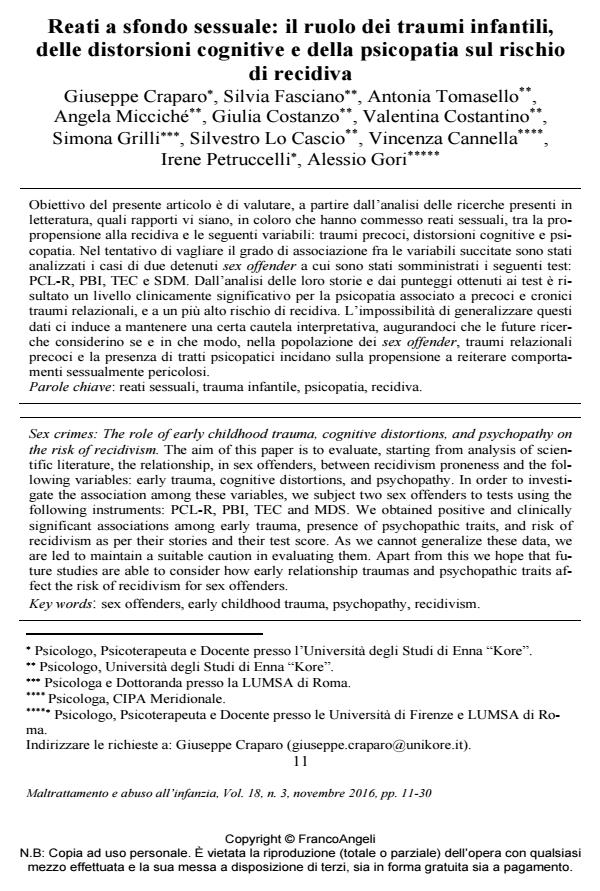Reati a sfondo sessuale: il ruolo dei traumi infantili, delle distorsioni cognitive e della psicopatia sul rischio di recidiva
Titolo Rivista MALTRATTAMENTO E ABUSO ALL’INFANZIA
Autori/Curatori Giuseppe Craparo, Silvia Fasciano, Antonia Tomasello, Angela Micciché, Giulia Costanzo, Valentina Costantino, Simona Grilli, Silvestro Lo Cascio, Vincenza Cannella, Irene Petruccelli, Alessio Gori
Anno di pubblicazione 2017 Fascicolo 2016/3
Lingua Italiano Numero pagine 20 P. 11-30 Dimensione file 284 KB
DOI 10.3280/MAL2016-003002
Il DOI è il codice a barre della proprietà intellettuale: per saperne di più
clicca qui
Qui sotto puoi vedere in anteprima la prima pagina di questo articolo.
Se questo articolo ti interessa, lo puoi acquistare (e scaricare in formato pdf) seguendo le facili indicazioni per acquistare il download credit. Acquista Download Credits per scaricare questo Articolo in formato PDF

FrancoAngeli è membro della Publishers International Linking Association, Inc (PILA)associazione indipendente e non profit per facilitare (attraverso i servizi tecnologici implementati da CrossRef.org) l’accesso degli studiosi ai contenuti digitali nelle pubblicazioni professionali e scientifiche
Obiettivo del presente articolo è di valutare, a partire dall’analisi delle ricerche presenti in letteratura, quali rapporti vi siano, in coloro che hanno commesso reati sessuali, tra la pro-propensione alla recidiva e le seguenti variabili: traumi precoci, distorsioni cognitive e psi-copatia. Nel tentativo di vagliare il grado di associazione fra le variabili succitate sono stati analizzati i casi di due detenuti sex offender a cui sono stati somministrati i seguenti test: PCL-R, PBI, TEC e SDM. Dall’analisi delle loro storie e dai punteggi ottenuti ai test è risultato un livello clinicamente significativo per la psicopatia associato a precoci e cronici traumi relazionali, e a un più alto rischio di recidiva. L’impossibilità di generalizzare questi dati ci induce a mantenere una certa cautela interpretativa, augurandoci che le future ricerche considerino se e in che modo, nella popolazione dei sex offender, traumi relazionali precoci e la presenza di tratti psicopatici incidano sulla propensione a reiterare comportamenti sessualmente pericolosi.
Parole chiave:Reati sessuali, trauma infantile, psicopatia, recidiva
Giuseppe Craparo, Silvia Fasciano, Antonia Tomasello, Angela Micciché, Giulia Costanzo, Valentina Costantino, Simona Grilli, Silvestro Lo Cascio, Vincenza Cannella, Irene Petruccelli, Alessio Gori, Reati a sfondo sessuale: il ruolo dei traumi infantili, delle distorsioni cognitive e della psicopatia sul rischio di recidiva in "MALTRATTAMENTO E ABUSO ALL’INFANZIA" 3/2016, pp 11-30, DOI: 10.3280/MAL2016-003002